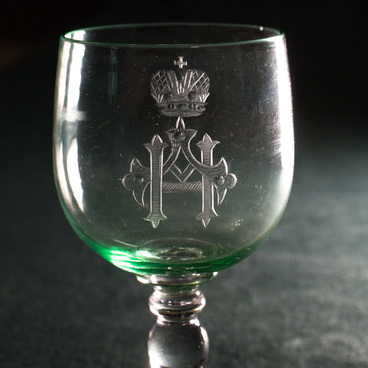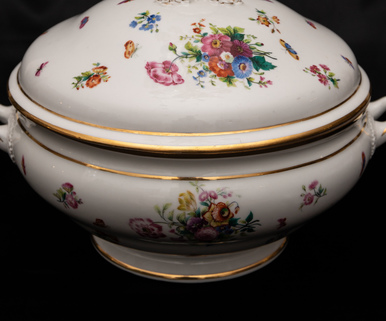The biscuit dish from the collection of the Tobolsk Historical and Architectural Museum-Reserve was made in the workshops of the Polish company Fraget. A wide flat vase was attached to a round stepped base on a low leg. And the base, in turn, rested on three legs in the form of folded leaves. The biscuit dish was used for serving sweet rusks and biscuits. Similar dishes were also made in the form of baskets; however, legged vases were more popular. The underside of the item has an intact FRAGET manufacture mark.
The Fraget company produced copper and brass products, silver plated in a special way. It was named after its founder Josef Fraget, who organized in 1824 the first laboratory in Warsaw to coat dishes made of base metals in silver or gold. Under the same name, his heirs opened shops and warehouses in large cities of the Russian Empire. The factory got prestigious awards and medals for its products at numerous exhibitions. At the All-Russian Exhibition in Nizhny Novgorod in 1896, it received the right to depict the State Russian Coat of Arms. The company was a supplier to many royal courts.
The silvering method used by the Fraget brothers was complex for its time: a thin sheet of silver foil was laid on red-hot copper and rolled with a press. With the help of electric current, silver fused with copper. In use, such a material did not peel off and looked like fine silver. Such a product was called plated, later they began to call that kind of material plated silver.
Inexpensive ‘imitation silver’ tableware made in Poland was popular until the 1930s. It was used both at the court of Emperor Nicholas II and at the Governor’s House in Tobolsk during the imperial family’s forced exile.
The title of suppliers was granted only for the duration of work being carried out or deliveries made to the Highest Court. The honourary title ‘Supplier to the Court’ was given by the Ministry of the Imperial Court, which was established in August 1826 and answered directly to Emperor.
The Fraget company produced copper and brass products, silver plated in a special way. It was named after its founder Josef Fraget, who organized in 1824 the first laboratory in Warsaw to coat dishes made of base metals in silver or gold. Under the same name, his heirs opened shops and warehouses in large cities of the Russian Empire. The factory got prestigious awards and medals for its products at numerous exhibitions. At the All-Russian Exhibition in Nizhny Novgorod in 1896, it received the right to depict the State Russian Coat of Arms. The company was a supplier to many royal courts.
The silvering method used by the Fraget brothers was complex for its time: a thin sheet of silver foil was laid on red-hot copper and rolled with a press. With the help of electric current, silver fused with copper. In use, such a material did not peel off and looked like fine silver. Such a product was called plated, later they began to call that kind of material plated silver.
Inexpensive ‘imitation silver’ tableware made in Poland was popular until the 1930s. It was used both at the court of Emperor Nicholas II and at the Governor’s House in Tobolsk during the imperial family’s forced exile.
The title of suppliers was granted only for the duration of work being carried out or deliveries made to the Highest Court. The honourary title ‘Supplier to the Court’ was given by the Ministry of the Imperial Court, which was established in August 1826 and answered directly to Emperor.



